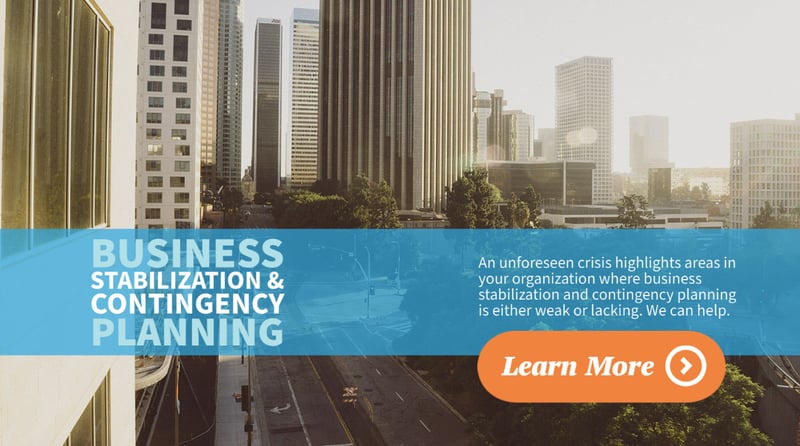The impact of COVID-19 has challenged business leaders with continuing to protect the health of their employees and businesses while adapting to a “new normal” of working. In the midst of economic challenges and uncertainty, leaders must reclaim control from unprecedented headwinds while discovering new ways to thrive. It is vital for leaders to develop KPIs and scenario planning methods to successfully adapt to the rapidly changing business environment and deal with the uncertainties that have been brought upon through the COVID-19 crisis.
As the economy reopens and businesses pave their way to recovery, leaders will need to develop dynamic strategic responses to stabilize and then grow. It is critical to balance a response to near-term headwinds while maintaining a long-term focus. Here are thoughts on how to focus on the right KPIs and scenario planning components to create that balance.
Top Scenario Planning Components
Now, more than ever, it is important to develop business plans based on scenarios that are tailored to your company. Here are some items to consider during planning:
- Identify the uncertainties and assign a range of potential outcomes.
- External factors include the timing of the economy’s reopening, the pace of an economic rebound and government interventions.
- Internal factors include cost reduction initiatives, workforce changes, supply chain initiatives, etc.
- Identify key variables that will affect revenue, costs, operations and cash flow assumptions and design responses to various “fire drills” that may occur under different scenarios.
- Use this period of difficulty to reexamine success from a strategic planning perspective, both near-term and long-term.
Reassess Current KPIs and Business Metrics
Crises make it difficult to predict what will come next and upend business as usual. It is likely that some of the traditional measures leveraged pre-Coronavirus are now less relevant or lower priority.
- Identify and track only the key metrics that will directly impact the scenarios you have outlined and have the highest potential bearing on your business.
- Keep the list short and simple so that your organization can remain focused and in control. The brevity of the list will allow for quickly tackling and communicating issues as they arise.
Key Scenario Planning Metrics in a Crisis like COVID-19
Business leaders need full visibility into certain metrics to prioritize and respond quickly and effectively. Listed below are examples of financial, operational, cash management metrics that are most relevant in this new COVID-19 landscape.
How will you maintain a productive workforce while prioritizing health?
- % workforce by COVID-19 risk exposure level and location
- Employee performance and productivity as workplace setups have changed
- Employee surveys, including effectiveness of communication and employee wellness
What are your customers’ needs and concerns?
- Issues log to address immediate concerns
- Customer readiness to restart and assistance needed
How will you manage your cash flow in the near term?
- Daily or weekly cash inflows and outflows
- Weekly cash flow forecast
- POs in a queue prior to commitments
- Vendor payments prior to release
- Cash collection at risk and customers slow to pay
What is in your sales queue?
- Weekly sales and volume
- Sales Pipeline
- Pricing changes
- Sales risks
How will you balance the current level of inventory on hand and demand as you resume business?
- Weekly inventory on-hand for critical parts
- Demand forecast to restart
- Supplier readiness to restart and lead time needed
How has COVID-19 impacted manufacturing operations?
- Yield trend
- Factory utilization trend
Then take a deeper look at COVID-19-related expenses.
What is temporary and what will be the new normal for the future of work?
Next Steps and Using Scenario Planning to Look Ahead
Given the rapidly evolving external factors, closely monitor leading macroeconomic indicators, including trade policies that are specific to your industry. Track how your business is trending relative to evolving changes in timelines impacted by broader regulations.
Although we are facing unprecedented times and scenarios, these metrics will provide guidance around time, cost and resources, and raise immediate issues for leadership teams to make the informed decisions and prioritize executional steps.
If you’d like to learn more about financial planning & analysis in a time of crisis, then we recommend you explore our guide to business stabilization, which linked in the image below.
It explores the manner in which we’ve been working with clients, including updating forecasts and assumptions and developing scenario planning. It also covers the importance of KPIs and streamlined management reporting, and it’s free to download:

About the Author
Carol has extensive experience in finance, accounting, strategic planning, financial modeling, transactional due diligence support, corporate restructuring, contract negotiations & administration, business development and operations. Her industry expertise covers healthcare, manufacturing, aerospace, bio-tech and entertainment companies ranging from start-up to the Fortune 500. Prior to 8020, she held Controller and Finance Leadership positions at companies including, ITT, SmithKline Beecham and Quest Diagnostics, Paramount Pictures, Quallion LLC and Catalytic Solutions. She is a six sigma greenbelt and successfully led various cost savings initiatives in inventory controls, process improvements, financial system integrations as well as cash flow projections and controls. She holds a BA in Economics from UCLA and an MBA from Pepperdine University.




[…] solid strategic framework allows the company to set specific strategic goals that can be monitored and measured through key performance indicators (KPIs). These KPIs provide an easy way to define success and measure and share results and goals within […]